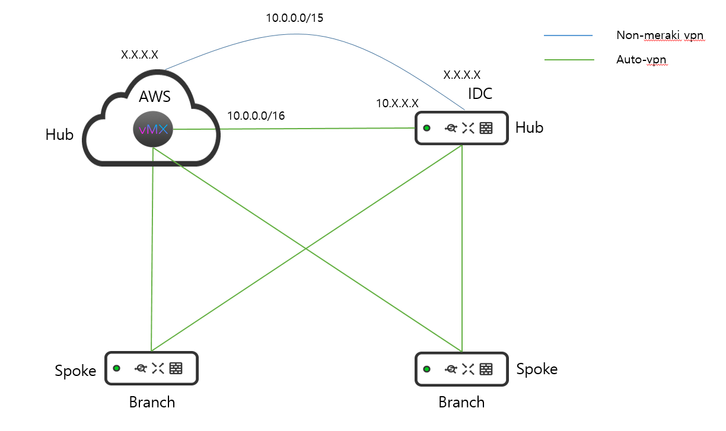Get answers from our community of experts in record time.
Join now- Technical Forums
- :
- Security & SD-WAN
- :
- I'm not sure what hub-spoke means in Auto VPN.
I'm not sure what hub-spoke means in Auto VPN.
Solved- Subscribe to RSS Feed
- Mark Topic as New
- Mark Topic as Read
- Float this Topic for Current User
- Bookmark
- Subscribe
- Mute
- Printer Friendly Page
- Mark as New
- Bookmark
- Subscribe
- Mute
- Subscribe to RSS Feed
- Permalink
- Report Inappropriate Content
I'm not sure what hub-spoke means in Auto VPN.
Hi`
I have it configured as shown below.
From: Branch
Destination: AWS internal server
The branch MX devices have registered vMX and IDC as hubs.
And on the IDC, we connected the AWS VPN as a backup.
I removed the hub setting for vMX from the branch, leaving only the IDC.
There are no hub settings between the IDC and vMX.
I thought this would automatically fail over to AWS VPN, but it didn't.
It seems that the Hub-Spoke use is just for centralization, and the MXs still share the subnet when the Hub is removed. Is this correct?
Solved! Go to solution.
- Labels:
-
3rd Party VPN
-
Auto VPN
-
AWS
- Mark as New
- Bookmark
- Subscribe
- Mute
- Subscribe to RSS Feed
- Permalink
- Report Inappropriate Content
That's correct. Every network in the Auto-VPN can (by default) reach every other network.
The hub and spoke model is designed to limit the overhead of creating a full mesh of tunnels to every MX/Branch.
Spoke to spoke communication (in this case tunneled via the hub) can be prevented using site-to-site firewall rules.
- Mark as New
- Bookmark
- Subscribe
- Mute
- Subscribe to RSS Feed
- Permalink
- Report Inappropriate Content
Non meraki vpn subnets cant be reached from mx devices that do not have the non meraki vpn itself.
- Mark as New
- Bookmark
- Subscribe
- Mute
- Subscribe to RSS Feed
- Permalink
- Report Inappropriate Content
Hi @ww
Thank you for your response.
We are configured to use a non-meraki vpn to communicate with aws when vMX is down.
- Mark as New
- Bookmark
- Subscribe
- Mute
- Subscribe to RSS Feed
- Permalink
- Report Inappropriate Content
That's correct. Every network in the Auto-VPN can (by default) reach every other network.
The hub and spoke model is designed to limit the overhead of creating a full mesh of tunnels to every MX/Branch.
Spoke to spoke communication (in this case tunneled via the hub) can be prevented using site-to-site firewall rules.
- Mark as New
- Bookmark
- Subscribe
- Mute
- Subscribe to RSS Feed
- Permalink
- Report Inappropriate Content
Hi @Brash
First of all, thank you for your response.
As you say, the hub-spoke feature reduces overhead by preventing VPN connections between spoke<->spoke, and eases firewall policy by forcing them to communicate with the hub, correct?
Thank you!
- Mark as New
- Bookmark
- Subscribe
- Mute
- Subscribe to RSS Feed
- Permalink
- Report Inappropriate Content
i believe the primary advantage of hub-spoke model is it decreases the overhead on the branch MX's.
In a full mesh setup, you end up creating a lot of tunnels which at scale has a performance impact. The number of tunnels grows incredibly quickly with additional branches and/or WAN connections.
The advantage of hub-spoke is that the branches will only ever have tunnels to the hub, thereby vastly decreasing the number of required tunnels.
This doc has some good details about it.
- Mark as New
- Bookmark
- Subscribe
- Mute
- Subscribe to RSS Feed
- Permalink
- Report Inappropriate Content
Imagine a bicycle wheel, with the hub in the centre, receiving the connection from each independent spoke..
Like what you see? - Give a Kudo ## Did it answer your question? - Mark it as a Solution 🙂
All code examples are provided as is. Responsibility for Code execution lies solely your own.
- Mark as New
- Bookmark
- Subscribe
- Mute
- Subscribe to RSS Feed
- Permalink
- Report Inappropriate Content
Hi @rhbirkelund
-
3rd Party VPN
162 -
ACLs
88 -
Auto VPN
287 -
AWS
35 -
Azure
66 -
Client VPN
366 -
Firewall
832 -
iOS
1 -
Other
538 -
Wireless LAN MR
1

